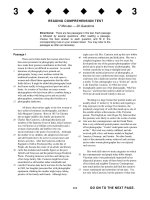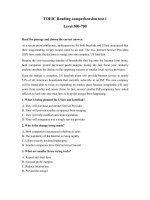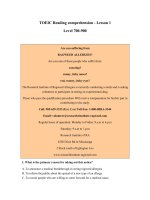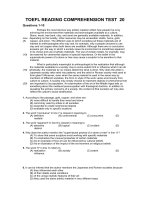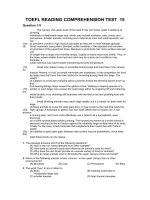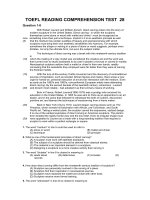TOEFL READING COMPREHENSION TEST 20
Bạn đang xem bản rút gọn của tài liệu. Xem và tải ngay bản đầy đủ của tài liệu tại đây (77.1 KB, 7 trang )
TOEFL READING COMPREHENSION TEST 20
Questions 1-10
Perhaps the most obvious way artistic creation reflect how people live is by
mirroring the environment-the materials and technologies available to a culture.
Stone, wood, tree bark, clay, and sand are generally available materials. In addition,
Line depending on the locality, other resources may be accessible: shells, horns, gold,
(5) copper, and silver. The different uses to which societies put these materials are of
interest to anthropologists who may ask, for example, why a people chooses to use
clay and not copper when both items are available. Although there are no conclusive
answers yet, the way in which a society views its environment is sometimes apparent
in its choice and use of artistic materials. The use of certain metals, for example, may
(10) be reserved for ceremonial objects of special importance. Or the belief in the
supernatural powers of a stone or tree may cause a sculptor to be sensitive to that
material.
What is particularly meaningful to anthropologist is the realization that although
the materials available to a society may to some extent limit or influence what it can do
(15) artistically, the materials by no means determine what is done. Why does the artist in
Japanese society rake sand into patterns; and the artist in Roman society melt sand to
form glass? Moreover, even when the same material is used in the same way by
members of different societies, the form or style of the work varies enormously from
culture to culture. A society may simply choose to represent objects or phenomena that
(20) are important to its population. An examination of the art of the Middle Ages tells us
something about the medieval preoccupation with theological doctrine. In addition to
revealing the primary concerns of a society, the content of that society's art may also
reflect the culture's social stratification.
1. According to the passage, gold, copper, and silver are
(A) more difficult to handle than wood and stone
(B) commonly used by artists in all societies
(C) essential to create ceremonial objects
(D) available only in specific locations
2. The word "conclusive" in line 7 is closest in meaning to
(A) definitive (B) controversial (C) concurrent (D)
realistic
3. The word "apparent" in line 8 is closest in meaning to
(A) attractive (B) logical (C) evident (D)
distinct
4. Why does the author mention the "supernatural powers of a stone or tree" in line 11?
(A) To show that some sculptors avoid working with specific materials
(B) To emphasize the unusual properties of certain materials
(C) As an example of how art can be influenced by cultural beliefs
(D) As an illustration of the impact of the environment on religious beliefs
5. The word "it" in line 14 refers to
(A) realization (B) society (C) extent (D)
influence
6. It can be inferred that the author mentions the Japanese and Roman societies because
(A) they influenced each other
(B) of their stable social conditions
(C) of the unique stylistic features of their art
(D) they used the same artistic material in very different ways
7. According to the passage, all of the following statements about sand are true EXCEPT
(A) It is used to create glass.
(B) Roman artists mix it into their paints.
(C) Its use varies from culture to culture.
(D) Japanese artists use it to create artistic patterns.
8. The word "Moreover" in line 17 is closest in meaning to
(A) similarly (B) in addition (C) in contrast (D)
frequently
9. The word "preoccupation" in line 21 is closest in meaning to
(A) involvement (B) separation (C) relationship (D)
argument
10. The word "primary" in line 22 is closest in meaning to
(A) discrete (B) preliminary (C) ideal (D)
fundamental
Questions 11-22
Fungi, of which there are over 100,000 species, including yeasts and other
single-celled organisms as well as the common molds and mushrooms, were
formerly classified as members of the plant kingdom. However, in reality they are
Line very different from plants and today they are placed in a separate group altogether.
(5) The principal reason for this is that none of them possesses chlorophyll, and since
they cannot synthesize their own carbohydrates, they obtain their supplies either
from the breakdown of dead organic matter or from other living organisms.
Furthermore the walls of fungal cells are not made of cellulose, as those of plants
are, but of another complex sugarlike polymer called chitin, the material from which
(10) the hard outer skeletons of shrimps, spiders, and insects are made. The difference
between the chemical composition of the cell walls of fungi and those of plants
is of enormous importance because it enables the tips of the growing hyphae, the
threadlike cells of the fungus, to secrete enzymes that break down the walls of plant
cells without having any effect on those of the fungus itself. It is these cellulose –
(15) destroying enzymes that enable fungi to attack anything made from wood, wood
pulp, cotton, flax, or other plant material.
The destructive power of fungi is impressive. They are a major cause of
structural
damage to building timbers, a cause of disease in animals and humans, and one of
the greatest causes of agricultural losses. Entire crops can be wiped out by fungal
(20) attacks both before and after harvesting. Some fungi can grow at + 50
O
C, while
others can grow at -5C, so even food in cold storage may not be completely safe
from them. On the other hand, fungi bring about the decomposition of dead organic
matter, thus enriching the soil and returning carbon dioxide to the atmosphere. They
also enter into a number of mutually beneficial relationships with plants and other
(25) organisms. In addition, fungi are the source of many of the most potent antibiotics
used in clinical medicine, including penicillin.
11. What does paragraph 1 mainly discuss?
(A) Differences between simply and complex fungi
(B) Functions of chlorophyll in plants
(C) Functions of sugar in the walls of fungal cells
(D) Differences between fungi and plants
12. Which of the following is mentioned as a major change in how scientists approach the
study of fungi?
(A) Fungi are no longer classified as plants
(B) Some single-cell organisms are no longer classified as fungi.
(C) New methods of species identification have been introduced
(D) Theories about the chemical composition of fungi have been revised.
13. The word "principal" in line 5 is closest in meaning to
(A) true (B) main (C) logical (D)
obvious
14. According to the passage, how do fungi obtain carbohydrates?
(A) The absorb carbohydrates from their own cell walls.
(B) They synthesize chlorophyll to produce carbohydrates.
(C) They produce carbohydrates by breaking down chitin.
(D) They acquire carbohydrates from other organic matter, both living and dead.
15. The passage mentions shrimps, spiders, and insects in line 10 because their skeletons
(A) can be destroyed by fungi
(B) have unusual chemical compositions
(C) contain a material found in the walls of fungal cells
(D) secrete the same enzymes as the walls of fungal cells do
16. Which of the following terms is defined in the passage?
(A) "chlorophyll" (line 5) (B) "polymer" (line 9)
(C) "hyphae" (line 12) (D) "enzymes" (line 13)
17. The word "those" in line 14 refers to
(A) tips (B) hyphae (C) enzymes (D) walls
18. Fungi have all of the following characteristics EXCEPT
(A) They grow hyphae. (B) They secrete enzymes.
(C) They synthesize cellulose. (D) They destroy crops.
19. The word "Entire" in line 19 is closest in meaning to
(A) certain (B) whole (C) mature (D)
diseased
20. The passage describes the negative effects of fungi on all the following EXCEPT
(A) buildings (B) animals (C) food (D) soil
21. The phrase "bring about" in line 22 is closest in meaning to
(A) cause (B) join (C) take (D)
include
22. The passage mentions "penicillin" in line 26 as an example of
(A) a medicine derived from plants
(B) a beneficial use of fungi
(C) a product of the relationship between plants and fungi
(D) a type of fungi that grows at extreme temperatures.
Questions 23-33
The history of clinical nutrition, or the study of the relationship between health
and how the body takes in and utilizes food substances, can be divided into four
distinct eras: the first began in the nineteenth century and extended into the early
Line twentieth century when it was recognized for the first time that food contained
(5) constituents that were essential for human function and that different foods provided
different amounts of these essential agents. Near the end of this era, research studies
demonstrated that rapid weight loss was associated with nitrogen imbalance and
could only be rectified by providing adequate dietary protein associated with certain
foods.
(10) The second era was initiated in the early decades of the twentieth century and
might be called "the vitamin period." Vitamins came to be recognized in foods, and
deficiency syndromes were described. As vitamins became recognized as essential
food constituents necessary for health, it became tempting to suggest that every
disease and condition for which there had been no previous effective treatment might
(15) be responsive to vitamin therapy. At that point in time, medical schools started to
become more interested in having their curricula integrate nutritional concepts into
the basic sciences. Much of the focus of this education was on the recognition of
vitamin deficiency symptoms. Herein lay the beginning of what ultimately turned from
ignorance to denial of the value of nutritional therapies in medicine. Reckless
(20) claims were made for effects of vitamins that went far beyond what could actually
be achieved from the use of them.
In the third era of nutritional history in the early 1950's to mid-1960's, vitamin
therapy began to fall into disrepute. Concomitant with this, nutrition education in
medical schools also became less popular. It was just a decade before this that many
(25) drug companies had found their vitamin sales skyrocketing and were quick to supply
practicing physicians with generous samples of vitamins and literature extolling the
virtue of supplementation for a variety of health-related conditions. Expectations
as to the success of vitamins in disease control were exaggerated. As is known in
retrospect, vitamin and mineral therapies are much less effective when applied to
(30) health-crisis conditions than when applied to long-term problems of under nutrition
that lead to chronic health problems.
23. What does the passage mainly discuss?
(A) The effects of vitamins on the human body
(B) The history of food preferences from the nineteenth century to the present
(C) The stages of development of clinical nutrition as a field of study
(D) Nutritional practices of the nineteenth century
24. It can be inferred from the passage that which of the following discoveries was made
during the first era in the history of nutrition?
(A) Protein was recognized as an essential component of diet.
(B) Vitamins were synthesized from foods.
(C) Effective techniques of weight loss were determined.
(D) Certain foods were found to be harmful to good health.
25. The word "tempting" in line 13 is closest in meaning to
(A) necessary (B) attractive (C) realistic (D)
correct
26. It can be inferred from the passage that medical schools began to teach concepts of
nutrition in order to
(A) convince medical doctors to participate in research studies on nutrition
(B) encourage medical doctors to apply concepts of nutrition in the treatment of disease
(C) convince doctors to conduct experimental vitamin therapies on their patients
(D) support the creation of artificial vitamins
27. The word "Reckless" in line 19 is closest in meaning to
(A) recorded (B) irresponsible (C) informative (D) urgent
28. The word 'them" in line 21 refers to
(A) therapies (B) claims (C) effects (D)
vitamins
29. Why did vitamin therapy begin losing favor in the 1950's
(A) The public lost interest in vitamins.
(B) Medical schools stopped teaching nutritional concepts.
(C) Nutritional research was of poor quality
(D) Claims for the effectiveness of vitamin therapy were seen to be exaggerated.
30. The phrase "concomitant with" in line 23 is closest in meaning to
(A) in conjunction with (B) prior to (C) in dispute with (D)
in regard to
31. The word "skyrocketing" in line 25 is closest in meaning to
(A) internationally popular (B) increasing rapidly
(C) acceptable (D) surprising
32. The word "extolling" in line 26 is closest in meaning to
(A) analyzing (B) questioning (C) praising (D)
promising
33. The paragraph following the passage most probably discusses
(A) the fourth era of nutrition history (B) problems associated with
undernutrition
(C) how drug companies became successful (D) why nutrition education lost its
appeal
Questions 34-43
The observation of the skies has played a special part in the lives and cultures of
peoples since the earliest of times. Evidence obtained from a site known as the Hole
in the Rock, in Papago Park in Phoenix, Arizona, indicates that it might have been
Line used as an observatory by a prehistoric people known as the Hohokam.
(5) The physical attributes of the site allow its use as a natural calendar/clock. The
"hole" at Hole in the Rock is formed by two large overhanging rocks coming
together at a point, creating a shelter with an opening large enough for several
persons to pass through. The northeast-facing overhang has a smaller opening in its
roof. It is this smaller hole that produces the attributes that may have been used as a
(10) calendar clock.
Because of its location in the shelter's roof, a beam of sunlight can pass through
this second hole and cast a spot onto the shelter's wall and floor. This spot of light
travels from west to east as the sun moves across the sky. It also moves from north
to south and back again as the Earth travels around the Sun. the west-to-east
(15) movement could have been used to establish a daily clock, much like a sundial,
while the north-to-south movement could have been used to establish a seasonal
calendar.
The spot first appears and starts down the surface of the wall of the shelter at
different times of the morning depending on the time of the year. The spot grows in
(20) size from its first appearance until its maximum size is achieved roughly at midday.
It then continues its downward movement until it reaches a point where it jumps to
the floor of the shelter. As the Sun continues to move to the west, the spot continues
to move across the shelter floor and down the butte, or hill, toward a group of small
boulders. If a person is seated on a certain one of these rocks as the spot reaches it,
(25) the Sun can be viewed through the calendar hole. This occurs at different times in
the afternoon depending on the time of year.
34. What does the passage mainly discuss?
(A) Observations of the stars by ancient people
(B) Rock formations of Arizona
(C) A site used by ancient people to measure time
(D) The movement of the Earth around the Sun
35. The word "obtained" in line 2 is closest in meaning to
(A) acquired (B) transported (C) covered (D)
removed
36. The word "attributes" in line 5 is closest in meaning to
(A) changes (B) characteristics (C) locations (D)
dimensions
37. The word "its" in line 11 refers to
(A) roof (B) beam (C) hole (D) spot
38. The word "establish" in line 15 is closest in meaning to
(A) create (B) locate (C) consult (D)
choose
39. Which of the following is NOT true of the spot of light?
(A) It is caused by sunlight passing through a hole.
(B) It travels across the roof of the shelter.
(C) Its movement is affected by the position of the Sun.
(D) It movement could have been used to estimate the time of day.
40. From which of the following can be the time of year be determined?
(A) The movement of the spot of light from west to east
(B) The speed with which the spot of light moves
(C) The movement of the spot of light from north to south
(D) The size of the sport of light at midday
41. The word "roughly" in line 20 is closest in meaning to
(A) finally (B) harshly (C) uneasily (D)
approximately
42. The passage mentions that the Hole in the Rock was used as all of the following EXCEPT
(A) a calendar (B) a home (C) a clock (D) an
observatory
43. Which of the following can be inferred from the fourth paragraph?
(A) The boulders are located below the rock shelter.
(B) The person seated on the rock cannot see the shelter.
(C) After it passes the boulders, the spot of light disappears.
(D) The spot of light is largest when it first appears.
Questions 44-50
By the turn of the century, the middle-class home in North American had been
transformed. "The flow of industry has passed and left idle the loom in the attic, the
soap kettle in the shed," Ellen Richards wrote in 1908. The urban middle class was
Line now able to buy a wide array of food products and clothing-baked goods, canned
(5) goods, suits, shirts, shoes, and dresses. Not only had household production waned,
but technological improvements were rapidly changing the rest of domestic work.
Middle-class homes had indoor running water and furnaces, run on oil, coal, or gas,
that produced hot water. Stoves were fueled by gas, and delivery services provided
ice for refrigerators. Electric power was available for lamps, sewing machines, irons,
(10) and even vacuum cleaners. No domestic task was unaffected. Commercial laundries,
for instance, had been doing the wash for urban families for decades; by the early
1900's the first electric washing machines were on the market.
On impact of the new household technology was to raw sharp dividing lines
between women of different classes and regions. Technological advances always
(15) affected the homes of the wealthy first, filtering downward into the urban middle
class. But women who lived on farms were not yet affected by household
improvements. Throughout the nineteenth century and well into the twentieth, rural
homes lacked running water and electric power. Farm women had to haul large
quantities of water into the house from wells or pumps for every purpose. Doing the
(20) family laundry, in large vats heated over stoves, continued to be a full day's work,
just as canning and preserving continued to be seasonal necessities. Heat was
provided by wood or coal stoves. In addition, rural women continued to produce
most of their families' clothing. The urban poor, similarly, reaped few benefits from
household improvements. Urban slums such as Chicago's nineteenth ward often had
(25) no sewers, garbage collection, or gas or electric lines; and tenements lacked both
running water and central heating. At the turn of the century, variations in the nature
of women's domestic work were probably more marked than at any time before.
44. What is the main topic of the passage?
(A) The creation of the urban middle class
(B) Domestic work at the turn of the century
(C) The spread of electrical power in the United States
(D) Overcrowding in American cities.
45. According to the passage, what kind of fuel was used in a stove in a typical middle-class
household?
(A) oil (B) coat (C) gas (D) wood
46. Which of the following is NOT mentioned as a household convenience in the passage?
(A) the electric fan (B) the refrigerator
(C) the electric light (D) the washing machine
47. According to the passage, who were the first beneficiaries of technological advances?
(A) Farm women (B) The urban poor
(C) The urban middle class (D) The wealthy
48. The word "reaped" in line 23 is closest in meaning to
(A) gained (B) affected (C) wanted (D)
accepted
49. Which of the following best characterizes the passage's organization?
(A) analysis of a quotation (B) chronological narrative
(C) extended definition (D) comparison and contrast
50. Where in the passage does the author discuss conditions in poor urban neighborhoods?
(A) lines 3-5 (B) lines 7-8 (C) lines 9-10 (D) lines
24-26

